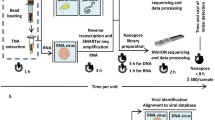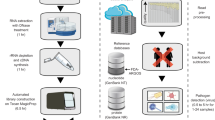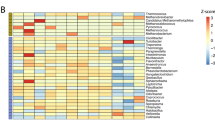Abstract
Metagenomic next-generation sequencing (mNGS), the shotgun sequencing of RNA and DNA from clinical samples, has proved useful for broad-spectrum pathogen detection and the genomic surveillance of viral outbreaks. An additional target enrichment step is generally needed for high-sensitivity pathogen identification in low-titre infections, yet available methods using PCR or capture probes can be limited by high cost, narrow scope of detection, lengthy protocols and/or cross-contamination. Here, we developed metagenomic sequencing with spiked primer enrichment (MSSPE), a method for enriching targeted RNA viral sequences while simultaneously retaining metagenomic sensitivity for other pathogens. We evaluated MSSPE for 14 different viruses, yielding a median tenfold enrichment and mean 47% (±16%) increase in the breadth of genome coverage over mNGS alone. Virus detection using MSSPE arboviral or haemorrhagic fever viral panels was comparable in sensitivity to specific PCR, demonstrating 95% accuracy for the detection of Zika, Ebola, dengue, chikungunya and yellow fever viruses in plasma samples from infected patients. Notably, sequences from re-emerging and/or co-infecting viruses that have not been specifically targeted a priori, including Powassan and Usutu, were successfully enriched using MSSPE. MSSPE is simple, low cost, fast and deployable on either benchtop or portable nanopore sequencers, making this method directly applicable for diagnostic laboratory and field use.
This is a preview of subscription content, access via your institution
Access options
Access Nature and 54 other Nature Portfolio journals
Get Nature+, our best-value online-access subscription
$32.99 / 30 days
cancel any time
Subscribe to this journal
Receive 12 digital issues and online access to articles
$119.00 per year
only $9.92 per issue
Buy this article
- Purchase on SpringerLink
- Instant access to full article PDF
Prices may be subject to local taxes which are calculated during checkout



Similar content being viewed by others
Data availability
Sequence data were deposited in the NCBI Sequence Read Archive after removal of human genomic reads (NCBI BioProject accession no. PRJNA578816, umbrella BioProject accession no. PRJNA171119). The data that support the findings of the study are available from the corresponding author on reasonable request. MSSPE primer sequences tested in this study are provided in Supplementary Table 21. Source data for Fig. 2 are presented with this paper.
Code availability
SURPI+, SURPIrt and MSSPE-design have been deposited on Github and are available for download for research use only at https://github.com/chiulab/SURPI-plus-dist, https://github.com/chiulab/SURPIrt-dist and https://github.com/chiulab/MSSPE-design, respectively.
Change history
21 January 2020
A Correction to this paper has been published: https://doi.org/10.1038/s41564-020-0671-7
References
Bloom, D. E., Black, S. & Rappuoli, R. Emerging infectious diseases: a proactive approach. Proc. Natl Acad. Sci. USA 114, 4055–4059 (2017).
Reperant, L. A. & Osterhaus, A. AIDS, Avian flu, SARS, MERS, Ebola, Zika… what next? Vaccine 35, 4470–4474 (2017).
Shorten, R. J. et al. Diagnostics in Ebola virus disease in resource-rich and resource-limited settings. PLoS Negl. Trop. Dis. 10, e0004948 (2016).
Rasmussen, A. L. & Katze, M. G. Genomic signatures of emerging viruses: a new era of systems epidemiology. Cell Host Microbe 19, 611–618 (2016).
Sozhamannan, S. et al. Evaluation of signature erosion in Ebola virus due to genomic drift and its impact on the performance of diagnostic assays. Viruses 7, 3130–3154 (2015).
Chiu, C. Y. & Miller, S. A. Clinical metagenomics. Nat. Rev. Genet. 20, 341–355 (2019).
Wilson, M. R. et al. Clinical metagenomic sequencing for diagnosis of meningitis and encephalitis. N. Engl. J. Med. 380, 2327–2340 (2019).
Simner, P. J., Miller, S. & Carroll, K. C. Understanding the promises and hurdles of metagenomic next-generation sequencing as a diagnostic tool for infectious diseases. Clin. Infect. Dis. 66, 778–788 (2018).
Wilson, M. R. et al. Actionable diagnosis of neuroleptospirosis by next-generation sequencing. N. Engl. J. Med. 370, 2408–2417 (2014).
Gardy, J. L. & Loman, N. J. Towards a genomics-informed, real-time, global pathogen surveillance system. Nat. Rev. Genet. 19, 9–20 (2018).
Gire, S. K. et al. Genomic surveillance elucidates Ebola virus origin and transmission during the 2014 outbreak. Science 345, 1369–1372 (2014).
Chiu, C. Y. Viral pathogen discovery. Curr. Opin. Microbiol. 16, 468–478 (2013).
Pollock, N. R. & Wonderly, B. Evaluating novel diagnostics in an outbreak setting: lessons learned from Ebola. J. Clin. Microbiol. 55, 1255–1261 (2017).
Salter, S. J. et al. Reagent and laboratory contamination can critically impact sequence-based microbiome analyses. BMC Biol. 12, 87 (2014).
Strong, M. J. et al. Microbial contamination in next generation sequencing: implications for sequence-based analysis of clinical samples. PLoS Pathog. 10, e1004437 (2014).
Greninger, A. L. et al. Rapid metagenomic identification of viral pathogens in clinical samples by real-time nanopore sequencing analysis. Genome Med. 7, 99 (2015).
Kafetzopoulou, L. E. et al. Metagenomic sequencing at the epicenter of the Nigeria 2018 Lassa fever outbreak. Science 363, 74–77 (2019).
Koehler, J. W. et al. Development and evaluation of a panel of filovirus sequence capture probes for pathogen detection by next-generation sequencing. PLoS ONE 9, e107007 (2014).
Quick, J. et al. Real-time, portable genome sequencing for Ebola surveillance. Nature 530, 228–232 (2016).
Faria, N. R. et al. Establishment and cryptic transmission of Zika virus in Brazil and the Americas. Nature 546, 406–410 (2017).
Grubaugh, N. D. et al. Genomic epidemiology reveals multiple introductions of Zika virus into the United States. Nature 546, 401–405 (2017).
Metsky, H. C. et al. Zika virus evolution and spread in the Americas. Nature 546, 411–415 (2017).
Faria, N. R. et al. Genomic and epidemiological monitoring of yellow fever virus transmission potential. Science 361, 894–899 (2018).
Song, H. et al. Tracking HIV-1 recombination to resolve its contribution to HIV-1 evolution in natural infection. Nat. Commun. 9, 1928 (2018).
Sardi, S. I. et al. Coinfections of Zika and chikungunya viruses in Bahia, Brazil, identified by metagenomic next-generation sequencing. J. Clin. Microbiol. 54, 2348–2353 (2016).
Briese, T. et al. Virome capture sequencing enables sensitive viral diagnosis and comprehensive virome analysis. mBio 6, e01491-15 (2015).
Metsky, H. C. et al. Capturing sequence diversity in metagenomes with comprehensive and scalable probe design. Nat. Biotechnol. 37, 160–168 (2019).
Wylie, T. N., Wylie, K. M., Herter, B. N. & Storch, G. A. Enhanced virome sequencing using targeted sequence capture. Genome Res. 25, 1910–1920 (2015).
Thézé, J. et al. Genomic epidemiology reconstructs the introduction and spread of Zika virus in Central America and Mexico. Cell Host Microbe 23, 855–864 (2018).
Lorenz, T. C. Polymerase chain reaction: basic protocol plus troubleshooting and optimization strategies. J. Vis. Exp. 63, e3998 (2012).
Cherpillod, P. et al. Ebola virus disease diagnosis by real-time RT-PCR: a comparative study of 11 different procedures. J. Clin. Virol. 77, 9–14 (2016).
Corman, V. M. et al. Assay optimization for molecular detection of Zika virus. Bull. World Health Organ. 94, 880–892 (2016).
Miller, S. et al. Laboratory validation of a clinical metagenomic sequencing assay for pathogen detection in cerebrospinal fluid. Genome Res. 29, 831–842 (2019).
Erlwein, O. et al. DNA extraction columns contaminated with murine sequences. PLoS ONE 6, e23484 (2011).
Naccache, S. N. et al. Distinct Zika virus lineage in Salvador, Bahia, Brazil. Emerg. Infect. Dis. 22, 1788–1792 (2016).
Quick, J. et al. Multiplex PCR method for MinION and Illumina sequencing of Zika and other virus genomes directly from clinical samples. Nat. Protoc. 12, 1261–1276 (2017).
Hasan, M. R. et al. Depletion of human DNA in spiked clinical specimens for improvement of sensitivity of pathogen detection by next-generation sequencing. J. Clin. Microbiol. 54, 919–927 (2016).
Gu, W. et al. Depletion of abundant sequences by hybridization (DASH): using Cas9 to remove unwanted high-abundance species in sequencing libraries and molecular counting applications. Genome Biol. 17, 41 (2016).
Stang, A., Korn, K., Wildner, O. & Uberla, K. Characterization of virus isolates by particle-associated nucleic acid PCR. J. Clin. Microbiol. 43, 716–720 (2005).
Temmam, S. et al. Host-associated metagenomics: a guide to generating infectious RNA viromes. PLoS ONE 10, e0139810 (2015).
Endoh, D. et al. Species-independent detection of RNA virus by representational difference analysis using non-ribosomal hexanucleotides for reverse transcription. Nucleic Acids Res. 33, e65 (2005).
Nguyen, A. T. et al. Development and evaluation of a non-ribosomal random PCR and next-generation sequencing based assay for detection and sequencing of hand, foot and mouth disease pathogens. Virol. J. 13, 125 (2016).
Ladner, J. T. et al. Standards for sequencing viral genomes in the era of high-throughput sequencing. mBio 5, e01360-14 (2014).
Robertson, D. L., Hahn, B. H. & Sharp, P. M. Recombination in AIDS viruses. J. Mol. Evol. 40, 249–259 (1995).
Lynch, R. M., Shen, T., Gnanakaran, S. & Derdeyn, C. A. Appreciating HIV type 1 diversity: subtype differences in Env. AIDS Res. Hum. Retroviruses 25, 237–248 (2009).
Tyler, A. D. et al. Evaluation of Oxford Nanopore’s MinION sequencing device for microbial whole genome sequencing applications. Sci. Rep. 8, 10931 (2018).
Berg, M. G. et al. A pan-HIV strategy for complete genome sequencing. J. Clin. Microbiol. 54, 868–882 (2016).
Lanciotti, R. S. et al. Genetic and serologic properties of Zika virus associated with an epidemic, Yap State, Micronesia, 2007. Emerg. Infect. Dis. 14, 1232–1239 (2008).
Katoh, K. & Standley, D. M. MAFFT: iterative refinement and additional methods. Methods Mol. Biol. 1079, 131–146 (2014).
Naccache, S. N. et al. A cloud-compatible bioinformatics pipeline for ultrarapid pathogen identification from next-generation sequencing of clinical samples. Genome Res. 24, 1180–1192 (2014).
Kearse, M. et al. Geneious Basic: an integrated and extendable desktop software platform for the organization and analysis of sequence data. Bioinformatics 28, 1647–1649 (2012).
Schmieder, R. & Edwards, R. Quality control and preprocessing of metagenomic datasets. Bioinformatics 27, 863–864 (2011).
Langmead, B. & Salzberg, S. L. Fast gapped-read alignment with Bowtie 2. Nat. Methods 9, 357–359 (2012).
Sovic, I. et al. Fast and sensitive mapping of nanopore sequencing reads with GraphMap. Nat. Commun. 7, 11307 (2016).
Acknowledgements
We thank N. Loman and J. Quick at the University of Birmingham for providing ZIKV tiling multiplex PCR primers. The following viral RNA extracts were obtained through Biodefense and Emerging Infections Resources, the National Institute of Allergy and Infectious Diseases (NIAID) and the National Institutes of Health (NIH): CCHFV, IbAr10200, NR-37382; LASV, Josiah, NR-31821; Rift Valley Fever Virus, ZH501, NR-37379; MeV, Edmonston strain, NR-44104. This work was also funded in part by Abbott Laboratories (C.Y.C.), NIH grant no. R33-AI129455 (C.Y.C.) from the NIAID, NIH grant no. R01-HL105704 (C.Y.C.) from the National Heart, Lung, and Blood Institute, the California Initiative to Advance Precision Medicine (C.Y.C.), the Charles and Helen Schwab Foundation (C.Y.C.), the Steven and Alexandra Cohen Foundation (C.Y.C.), United States Department of Defense award W81XWH-17-1-0681 (C.Y.C.), the Wellcome Trust and Royal Society/Sir Henry Dale Fellowship grant no. 204311/Z/16/Z (N.R.F.), the Global Challenges Research Fund grant no. 005073 (N.R.F.), the Oxford John Fell Research Fund grant no. 005166 (N.R.F.) and Africa Oxford grant no. AfiOx-48 (N.R.F.).
Author information
Authors and Affiliations
Contributions
C.Y.C. conceived, designed, and supervised the study, developed MSSPE-design software and SURPIrt pathogen identification software for nanopore sequencing and analysed data. X.D. coordinated the study, performed experiments and analysed data. A.A., G.Y. and S.S. performed experiments. S.F. and J.T. performed the bioinformatics analysis of sequence data. I.B., N.R.F., O.G.P., Z.N., J.M. and N.T. collected YFV samples from patients and extracted the viral RNA. S.Y., K.H., S. Me. and D.A.W. collected CHIKV and DENV samples from febrile travellers returning to the United States and extracted the viral RNA. P.M.-K., J.K., S.A.-M. and J.-J.M.-T. collected Ebola samples from patients and extracted the viral RNA. A.A.A. collected a clinical CSF sample from a patient with POWV meningoencephalitis. V.G. collected a clinical CSF sample from a patient with JCV meningoencephalitis. M.T. and J.L.P. cultured the Ebola Kikwit strain for use in MSSPE experiments. N.N., D.M., L.K., C.M., M.R., G.C. and J.R.H.Jr. collected clinical HIV samples from patients in Cameroon, genotyped the strains and performed qRT–PCR for viral titre estimates. J.E.M.-M., C.R.G.-B., S.L. and C.F.A. collected clinical ZIKV samples from patients in Mexico. S.A. and S. Mi. provided clinical HCV samples from patients in California, USA. M.S. and M.B. collected ZIKV and DENV samples from infected blood donors. C.Y.C. and X.D. wrote the manuscript. C.Y.C., X.D., M.R. and G.C. edited the manuscript. All authors read the manuscript and agreed to its contents.
Corresponding author
Ethics declarations
Competing interests
C.Y.C. is the director of the UCSF–Abbott Viral Diagnostics and Discovery Center and receives research support funding from Abbott Laboratories, Inc. X.D. and C.Y.C. are inventors on a patent application titled ‘Spiked Primer Design for Targeted Enrichment of Metagenomic Libraries’ (US application no. 62/667,344, filed 4 May 2018 by the University of California San Francisco) that includes a description of the methods and primer sets presented in this paper. A.A.A. is an employee of Karius, Inc.
Additional information
Publisher’s note Springer Nature remains neutral with regard to jurisdictional claims in published maps and institutional affiliations.
Supplementary information
Supplementary Information
Supplementary Figs. 1 and 2 and Supplementary Tables 1–18.
Supplementary Tables
Supplementary Tables 19–21.
Source data
Source Data Fig. 2
Statistical source data.
Rights and permissions
About this article
Cite this article
Deng, X., Achari, A., Federman, S. et al. Metagenomic sequencing with spiked primer enrichment for viral diagnostics and genomic surveillance. Nat Microbiol 5, 443–454 (2020). https://doi.org/10.1038/s41564-019-0637-9
Received:
Accepted:
Published:
Issue date:
DOI: https://doi.org/10.1038/s41564-019-0637-9
This article is cited by
-
Integrating DNA and RNA sequencing for enhanced pathogen detection in respiratory infections
Journal of Translational Medicine (2025)
-
Phylogenetic insights into the transmission dynamics of arthropod-borne viruses
Nature Reviews Genetics (2025)
-
Clinical metagenomics for diagnosis and surveillance of viral pathogens
Nature Reviews Microbiology (2025)
-
Comparative diagnostic performance of metagenomic and two targeted sequencing methods in lower respiratory infection
Scientific Reports (2025)
-
Characteristics of SARS-CoV-2 variants and potential co-infected pathogens in hospitalized patients based on metagenomic next-generation sequencing
Scientific Reports (2025)



